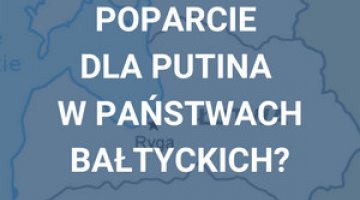Analyses
Results of the local government elections in Lithuania as a test of the mood before parliamentary elections
According to preliminary results, most votes in the local elections of 27th February were won by the opposition social democrats – 21.4%. The left for the past three years have been criticising the policy of governing the conservatives/Christian democrats and of the extremely unpopular prime minister and the party leader Andrius Kubilius. Victory for the left, however, is not overwhelming. Despite unpopular budget cuts and changes in the taxation policy (this latter led to protests), the governing right took second place in the local elections, backed by 16.3% of voters. Also the result gained by populist parties – the groupings of Rolandas Paksas (Order and Justice) and of Viktor Uspaskich (Labour Party) - competing against both the right and the left, was weaker than expected. Thus the results of the elections bring the presently governing right hope to maintain power after the parliamentary elections planned for autumn 2012.
The Electoral Action of Poles in Lithuania (EAPL – a grouping supported by a significant majority of ethnic Poles living in Lithuania making up 6.7% of the country’s citizens) achieved significant success. EAPL stood for elections with Russian Alliance (one of the organisations representing Russians living in Lithuania, constituting 6% of the country’s citizens) under the name of Waldemar Tomaszewski’s Block (from the name of the former EAPL leader, the most popular politician in Vilnius County, who presently is the only Pole to sit in the Lithuanian delegation at the European Parliament). In all regions populated by the Polish minority, its representatives strengthened their presence in local governments. Tomaszewski’s Block observed a spectacular success in Vilnius, where it took second place in the election to municipal council, nearly doubling its representation. Despite the fact that the Block put forward its candidates only in regions populated by national minorities (in some of them the Russian party stood individually), thanks to the high mobilisation of the Polish and Russian minorities it gained 6-percent support on the national level, giving them hope of crossing the 5% threshold in parliamentary elections for the first time.
The right and the left still the most popular
The elections were held according to the electoral law amended in 2010 which, apart from political parties and their blocks, also admitted independent candidates and their coalitions to stand for elections. Nevertheless, independent candidates won only 5% of councillor’s mandates, which proves that Lithuanian voters are still more willing to vote for political parties. Among them the most popular are still social democrats and conservatives/Christian democrats, with whom populist parties started to compete in the last decades.
The present elections may be treated as an important test of support for political parties before parliamentary elections in autumn 2012. The social democrats are admittedly the most popular group in the country, yet their criticism of the governing right was not convincing enough for the voters to significantly weaken their affection to the conservatives/Christian democrats. At the local government level the left has increased the number of its councillors (from 302 council members in the 2007 elections to 328 at present). The right has observed a slight drop (from 256 councillors to 249). Another success of the conservatives was to maintain a strong representation in the local government councils of the biggest cities – Vilnius and Kaunas. In the era of crisis voters decided to trust government policy, focusing their dissatisfaction with necessary austerity measures on the Prime Minister Andrius Kubilius. He is one of the least popular politicians (approval ratings in polls are at a level of 2-3%). Thus the conservatives/Christian democrats may decide to change the prime minister – the position may be taken by the present parliament speaker Irena Degutiene, who is a popular politician and may play the role of the right’s leader in the upcoming campaign.
Populists less and less popular
Pre-election polls forecasted greater support for the populists, especially for the Order and Justice party of President Rolandas Paksas, who was removed from power in 2004, which won 10.1% (155 councillors). A slightly better result was gained by the Labour Party of Viktor Uspaskich, a former businessman of Russian origin, member of the European Parliament (10.8% and 165 councillors). The victory of his party over Order and Justice is especially visible in Vilnius. On the other hand, the National Resurrection Party of Arunas Valinskas (second power in the parliament and the right’s main coalition actor) created just before the last parliamentary elections has not won a single mandate in local government councils. The elections results prove that Lithuanians are becoming less willing to support populist groups and those voters who are not happy with the rule of the right are now casting their votes mainly for the left.
Vilnius and Vilnius County – victory for regional groupings
The most spectacular success in the elections was achieved by an independent candidate, former capital city mayor and liberal centrist Arturas Zuokas (in block with the independent Vilnius Coalition). He stood in Vilnius only and won (17.68% of the votes, 12 mandates out of 51 in the municipal council). Admittedly Zuokas enjoys a reputation of the best mayor of the capital city, who solicited the restoration of the historic part of the city and promoted the development of a modern centre, but this has been ruined twice by notorious corruption scandals. He is a natural candidate for mayor provided he succeeds in creating a coalition. There is a chance that he will invite the second victor of the capital elections, i.e. the Waldemar Tomaszewski’s Block. Tomaszewski himself does not aspire for the position of mayor (he does not intend to give up his eurodeputy mandate and will not even accept the councillor’s mandate). Despite that, the Poles, who in alliance with the Russian minority nearly doubled their number of seats in the council from 6 to 11 (15.24% of support), also aspire to fill the post of mayor. Viktor Uspaskich is interested in making an alliance with both victors – a coalition created in this way would have a strong predominance over the remaining groupings. The Poles could man the posts of vice-mayors. Other coalition variants are still possible, including the present conservative mayor Raimondas Alekna keeping power (vice-mayor is an EAPL councillor).
EAPL has achieved an undisputable success in the Vilnius and Salcininkai area (where there are the greatest aggregations of Poles in Lithuania). In these local governments EAPL will not even have any opposition: in the Vilnius area it gained nearly 65% support, maintained 19 councillors in a 27-person council, and in the Salcininkai area more than 70% of voters cast their vote to Tomaszewski’s Block: it will have 22 councillors in a 25-person council. Waldemar Tomaszewski’s Block has also increased the number of its councillors in districts where Poles already had their representatives (Trakai and Svencionys regions). Through cooperation with the Russian minority, EAPL won mandates in new constituencies of Visaginas and Sirvintos for the first time.
The mobilisation of the Polish community is proof that national minorities are becoming increasingly more active, are assertively demanding the Lithuanian government to solve their problems (regarding education, the return of pre-war lands, the scope of the use of a minority language), and in view of the growing conflict with the country’s authorities, they want to have an direct impact on politics. Hence the next objectives of the Polish grouping are the parliamentary elections and passing the 5-percent threshold. The results of Tomaszewski’s Block prove that if the present mobilisation level of minority electorate is kept, it is possible to gain about 10 mandates and to create a separate parliamentary grouping consisting of Polish minority MPs in the Lithuanian Seimas. EAPL’s good results may also be used by conservatives to mobilise their own electorate which is susceptible to nationalist slogans. This forecasts an electoral campaign with strong national accents – both Lithuanian and Polish.
Appendix
Preliminary results (final results will be announced on 6th March)
Social Democrats – 328 councillor’s mandates
Homeland Union (conservatives)/Christian democrats – 249 mandates
Labour Party – 165 mandates
Order and Justice – 155 mandates
Lithuanian Peasant Popular Union – 147 mandates,
Liberal and Centre Union – 126 mandates,
Liberals’ Union – 98 mandates,
EAPL and Russian Alliance coalition –Waldemar Tomaszewski’s Block – 65 mandates (where 61 were gained by EAPL representatives and 4 by Russian Alliance)
New Union – 52 mandates
Lithuanian Centre Party – 19 mandates
Christians’ Party – 15 mandates
Arturas Zuokas Coalition and Vilnius Coalition – 12 (stood locally in Vilnius).
The remaining political groupings taking part in the elections, independent candidates and independent coalitions won a few mandates each. Five parties have no seats in local government councils, including one having representation in parliament – the National Resurrection Party of the former parliament leader Arunas Valinskas.
Division of mandates in a 51-person council of the City of Vilnius:
Arturas Zuokas and the Vilnius Coalition – 12
Tomaszewski’s Block – 11 (including 9 councillors from EAPL and 2 from Russian Alliance)
Homeland Union (conservatives)/Christian democrats – 10
Labour Party – 8
Social Democrats – 5
Order and Justice – 5




